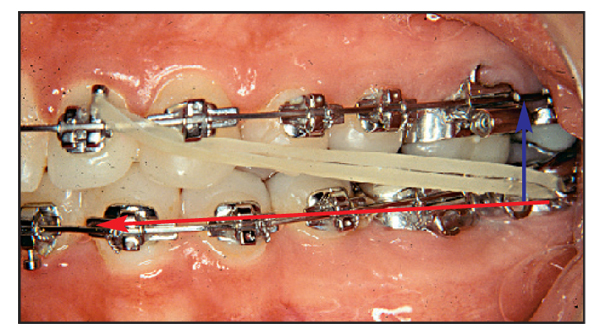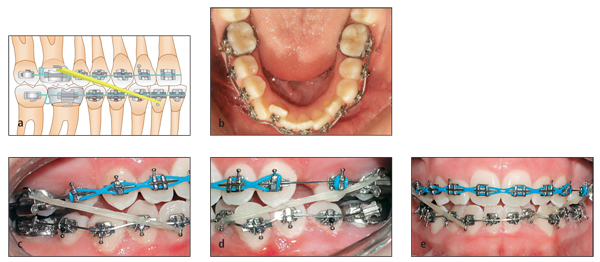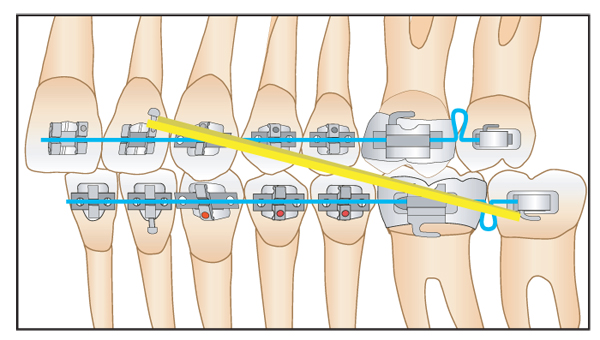
Use Intraoral Elastics to Coordinate the Arches
In the Alexander Discipline of orthodontic treatment, intraoral elastics are most commonly used to coordinate the arches. Although some orthodontists may use intra-arch elastics for space closure, this approach is seldom used in the Alexander Discipline. With the exception of finishing elastics, which will be discussed later in the section, elastics are used to reposition entire arches, not individual teeth.
As with any intraoral functional appliance, elastics are subject to Newton’s third law of motion—for every action, there is an equal and opposite reaction. This opposite reaction is most critical when the orthodontist is attempting to control the position of the mandibular incisors.
Sequence of Elastics
In general, the use of elastics in the Alexander Discipline system of biomechanics is divided into three sequences:
1. Early in treatment
• Crossbite elastics
• Class 3 elastics after bonding of the mandibular arch to prevent incisor flaring
2. Midtreatment
• Box elastics to help close open bites and/or level the mandibular arches
• Class 2 elastics for minimum mandibular anchorage in extraction cases
• Class 3 elastics to maximize mandibular anchorage in extraction cases
3. Finishing archwires
• Class 2 elastics to achieve occlusion in centric relation
• Midline elastics with class 2 or class 3 elastics (never combine midline and maxillomandibular elastics because they can cant the occlusal plane)
• Box elastics to improve occlusion
• Finishing elastics
In the transverse dimension, crossbite elastics and midline elastics can be useful. Vertically, the use of box elastics is necessary. For sagittal problems, class 2 or class 3 elastics are used.
Ball hooks are placed on the lateral brackets so that class 2 and class 3 elastics deliver a more horizontal force (Fig 16-1), which provides better vertical control. These hooks are also valuable when midline, box, and finishing elastics are placed.
Fig 16-1 Elastics attached to ball hooks on lateral incisor brackets can deliver four times more horizontal (red arrow) than vertical (blue arrow) force.
This principle presents a detailed outline to clarify the specifics of elastic use: where they are attached; the force they transmit; their purpose; and when and for how long they are worn. In addition, interested readers can review chapter 7 of my previous book1 for more information on the use of elastics.
Elastic Forces
Crossbite elastics (Fig 16-2)
• Where: Buccal surface of one molar to lingual surface of opposing molar (all molar bands have lingual hooks attached)
• Force: 3⁄16 inch; 6 oz
• Why: To correct posterior crossbites
• When: Early and/or late in treatment
• Time: 24 hours per day
Class 3 elastics (Fig 16-3)
• Where: Mandibular lateral incisor to maxillary first molar
• Force: ¼ inch; 3.5 oz
These elastics can be used for three different purposes:
1. • Why: To prevent advancement of the mandibular anterior teeth in a crowded nonextraction arch (Fig 16-3)
• When: Initial archwire in the mandibular arch
• Time: 72 hours, then nights only, with the facebow
2. • Why: To provide maximum anchorage in a bimaxillary protrusion extraction case
• When: Activation of the mandibular closing loops (wearing combination facebow)
• Time: 72 hours, then nights only, with the facebow
3. • Why: To correct Class III malocclusion
• When: Throughout treatment
• Time: Dependent on the severity of the problem
Fig 16-3 (a) Class 3 elastics attachment.(b) Crowded mandibular arch. (c, d, e) Class 3 elastics used early in treatment (72 hours) to prevent mandibular incisors from advancing.
Class 2 elastics (Fig 16-4)
The premature use of class 2 elastics can be very dangerous. If used with light archwires that cannot control torque, class 2 elastics can cause flaring of the mandibular anterior teeth, lingual tipping of the maxillary anterior teeth, mandibular molar extrusion, and alteration of the occlusal plane. Therefore, class 2 elastics should not be used until these other factors are under control.
• Where: Maxillary lateral incisor ball hook to mandibular first or second molar
• Force: ½ inch; 6 oz
These elastics can be used for two different purposes:
1. • Why: To correct Class II malocclusion
• When: Finishing archwires
• Time: 24 hours per day
2. • Why: To “burn” mandibular anchorage (move mandibular posterior teeth mesially) (Fig 16-5)
• When: Activation of mandibular closing loops
• Time: 72 hours, then nights only
Stay updated, free dental videos. Join our Telegram channel

VIDEdental - Online dental courses






